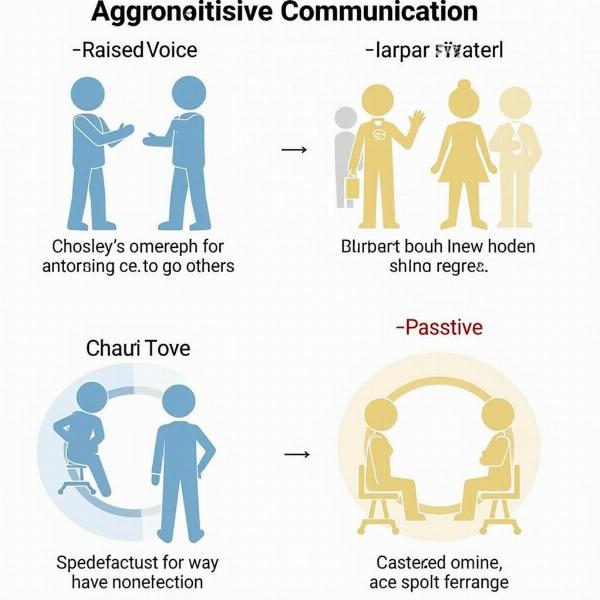Understanding the meaning of “aggressive” in Hindi is crucial for effective communication and navigating various social and professional situations. While a direct translation might not always capture the full nuance, several Hindi words convey the essence of aggressiveness, depending on the context. These range from assertive and competitive to hostile and even violent. Knowing these variations allows for more precise and culturally sensitive expression.
Exploring the Hindi Translations of “Aggressive”
The meaning of “aggressive” in Hindi can be expressed through various words, each with its own subtle connotations. Let’s delve into some of the most common translations and their usage:
-
आक्रामक (Aakramak): This is the most direct and commonly used translation for “aggressive.” It generally refers to someone who initiates action, often in a hostile or confrontational manner. Aakramak can describe anything from an aggressive salesperson to an aggressive military strategy.
-
उग्र (Ugra): This word implies a more intense and potentially dangerous form of aggression, often associated with anger or violence. It suggests a fierceness or vehemence that can be intimidating or even frightening. For example, you might describe an ugra protest or an ugra animal.
-
जोरदार (Jordaar): While not directly translating to “aggressive,” jordaar can describe an assertive and forceful approach. It emphasizes strength and determination, which in some contexts might be perceived as aggressive. For example, a jordaar argument or a jordaar performance.
-
प्रबल (Prabal): Similar to jordaar, prabal denotes strength and intensity, but with a focus on power and dominance. It suggests a strong and compelling force, which can be interpreted as aggressive in certain situations, like a prabal leader or a prabal wind.
-
हठी (Hathi): This word describes someone stubborn or obstinate, often refusing to compromise or consider other viewpoints. While not always directly aggressive, hathi behavior can certainly lead to conflict and be perceived as aggressive in interpersonal interactions.
Understanding the Contextual Usage of “Aggressive” in Hindi
Choosing the right Hindi word to convey “aggressive” depends heavily on the context. Consider the following examples:
-
Business: In a business setting, you might use “jordaar” or “prabal” to describe a competitive strategy, while “aakramak” could be used for a more direct and assertive sales approach. However, using “ugra” would likely be inappropriate and perceived negatively.
-
Sports: “Aakramak” is commonly used to describe an aggressive player or an aggressive playing style. “Jordaar” can also be used to highlight the strength and determination of a player.
-
Personal Relationships: “Hathi” might be used to describe an aggressive partner in a relationship, while “ugra” would be reserved for situations involving anger and potential violence.
 Aggressive Communication Styles
Aggressive Communication Styles
How to Appropriately Use “Aggressive” in Hindi Conversations
Using the appropriate Hindi word for “aggressive” demonstrates cultural sensitivity and ensures your message is conveyed accurately. Avoid using “ugra” unless you are describing a situation involving genuine anger or violence. In most cases, “aakramak,” “jordaar,” or “prabal” will be more suitable, depending on the specific nuance you want to express.
Expert Insight: Dr. Anjali Sharma, a renowned linguist specializing in Hindi, states, “Understanding the subtle differences between Hindi words for ‘aggressive’ is crucial for effective communication. Using the wrong word can lead to misunderstandings and even offend someone.”
Commonly Asked Questions About “Aggressive” in Hindi
-
What is the closest Hindi word to “aggressive”? The closest and most commonly used word is “aakramak (आक्रामक).”
-
Is it rude to use the word “ugra” in Hindi? While not inherently rude, “ugra” carries a strong connotation of anger and violence, so it should be used cautiously and only when appropriate.
-
How can I describe someone who is assertive but not aggressive in Hindi? “Jordaar (जोरदार)” or “prabal (प्रबल)” can be used to describe assertiveness without necessarily implying aggression.
-
What are some other ways to express aggression in Hindi? Phrases like “gusse se bhara (गुस्से से भरा)” (filled with anger) or “gussail (गुस्सैल)” (angry-tempered) can also describe aggressive tendencies.
-
Can the word “hathi (हठी)” be considered aggressive? While not directly aggressive, “hathi” can describe stubborn or obstinate behavior that might be perceived as aggressive in certain contexts.
-
How can I learn more about the nuances of Hindi words? Consulting a Hindi dictionary or language expert can provide deeper insights into the subtleties of word meanings.
-
What are some resources for learning Hindi? Numerous online resources, language learning apps, and textbooks are available for learning Hindi.
Conclusion
Understanding the various Hindi translations of “aggressive” is essential for accurate and culturally sensitive communication. By considering the context and choosing the appropriate word, you can avoid misunderstandings and ensure your message is conveyed effectively. Remember, using the right word can make all the difference in how you are perceived.
Meaning-Hindi.in: Your Partner in Hindi Translation
Meaning-Hindi.in is your one-stop solution for all your Hindi translation needs. We specialize in providing high-quality and accurate translations for a wide range of documents, including business and commercial materials, legal and certified documents, technical manuals, website content, educational and academic papers, and more. Our team of expert translators ensures that your message is conveyed accurately and effectively in Hindi. For fast, reliable, and professional Hindi translation services, contact us today at [email protected] or call us at +91 11-4502-7584. Meaning-Hindi.in – bridging the language gap between you and your Hindi-speaking audience.